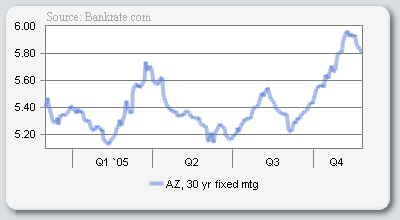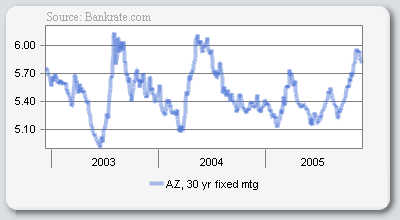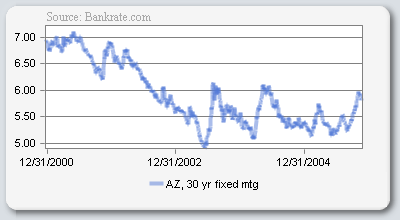Thursday, November 24, 2005
Digging for the news on interest rates
Mortgage rates around the country, which have been trending upward, dropped this week, offering a dose of good news for prospective home buyers.Newspapers are all about bad news reported on the shortest possible range of vision, so I suppose we should rejoice that the paper actually took note of some good short-term news. But the news of interest rates--and of real estate in general--is always about the long-term. The news of securities issues might matter day-to-day, but nobody buys a house one day and sells it the next.
Mortgage giant Freddie Mac reported Wednesday in its weekly survey that rates on 30-year, fixed-rate mortgages averaged 6.28 percent. That's down sharply from last week's rate of 6.37 percent, which was the highest in more than two years.
So: What's the real news on interest rates?
Take a look at this graph:

All of these charts come from BankRate.com. What we're looking at is the average rates for a 30-year fixed rate amortizing mortgage from Arizona lenders over the last 30 days. We hover between 5.70% and 5.96%, and the recent trend is decidedly downward. Good news, huh? Maybe not:

That's the three-month trend for a 30-tear fixed. The real trend is fairly steadily upward, right? But wait. There's more:

The same loan product over the last year. Down. Then up. Then back down. Then up a little. Then down a little. Then way up. Could it be that the sky really is falling?

Phew! The three-year trend looks like a Drunkard's Walk, a random stochastic hovering right around 5.40%. Interestingly, the trend seems to be flattening. But: If you read anything into that, you're making an error. Mortgage rates aren't caused by trends, trends are a coincidental artifact of changes in rates.
But here's the real news:

That's the five-year history of 30-year fixed rate mortgages in Arizona. Does that look like bad news to you? Does it look like bad news is lurking just around the corner, poised to strike?
Things can change. Disasters can befall us. Governments can inflict grievous errors on the national or international economy. But for now, at least, there is an awful lot of mortgage money out there looking for borrowers. This is why rates have been so low for so long. In the short-run, interest rates may be up a little or down a little. Over the long-term, assuming our economy stays on an even keel, the news is not just good, it's great.
posted by Greg Swann | 7:05 AM | 0 comments | links
Sunday, November 20, 2005
Rising rents keep sky from falling?
Here's further notice from the Arizona Republic:
According to Pierce Eislen, a Scottsdale market-research firm for the apartment industry, metro Phoenix apartment rental rates were up 4.3 percent in October over the same period a year ago. The average base rent was $697, up from $670 the previous October.Rents have been flat in the Phoenix market for a long time, but the same dyanmic--not static--market comes into play: If a 900sf three-bedroom apartment rents for $1,050 a month, how much more is a 1,400sf three-bedroom home worth? It's the competitive marketplace that 'decides,' ultimately, supply and demand. But through all of this, the supply of would-have-been home-buyers, tenants-for-now, is steadily increasing.
Rents had not risen significantly since 2001, said Ron Brock, Jr., vice president at Pierce Eislen.
Moreover, the number of apartments offering rental incentives dropped from 80 percent in 2004 to 43 percent this year through October, Pierce Eislen reported.
Several factors are converging to put the rental market in a better position to raise rents and drop concessions.
First, condo conversions are diminishing the stock of conventional apartment units faster than new stock is being built.
Second, the high median price of homes in the Valley is keeping many from owning their own home. And third, high land and construction costs are keeping apartment developers from building as many units as they traditionally have.
posted by Greg Swann | 7:10 AM | 0 comments | links
Saturday, November 19, 2005
After months of negotiations, the Sundome Center for the Performing Arts will soon be under new ownership.The Sundome is a failed arts venue, a failure even before newer and better free-market competition came on line. This "sale" simply moves its losses from one cadre of taxpayers to another.
The Maricopa County Board of Supervisors voted this week to approve the purchase of the 7,000-seat performing arts center.
The board agreed to pay $10 to the Arizona Board of Regents, the owner.
But there are three little ironies here: If the property had been "sold" for $10 to a private party, we would all understand that the taxpayers had been robbed by a sweetheart deal. But if ASU had sold the property at market value to a private developer, it would have received a huge sum of money for turning a vast parcel of land to a higher and better use. But, best of all, ASU will campaign next spring for the lion's share of a City of Phoenix bond issue to build a new campus for itself in Downtown Phoenix. If the taxpayers are willing to kick in yet another $855 million, ASU will be happy to donate the ten bucks it got from this "sale."
Actually, there is potential for a fourth and crowning irony:
Del E. Webb Corp. gave the Sundome to Arizona State University for $1 in 1984, with the university promising to keep it an arts venue.That reads like the grant to ASU may have been a qualified fee estate subject to condition subsequent, meaning that title would revert to Del Webb (now a division of Pulte Homes) if the property is not maintained as "an arts venue." But a common-enough provision in such a qualified fee estate would be that title would also have to vest in ASU, no other parties. In other words, it's possible that the original deed says that if ASU does not wish to retain the property, it automaticaly reverts back to Del Webb. The fallout from that would be an entertaining spectacle, worth ten bucks at least...
posted by Greg Swann | 9:25 AM | 0 comments | links
The cheapest metro area in the Realtors' report was Danville, Ill., where the median price in the third quarter was $72,800 -- a level that's scarcely imaginable to people house-hunting in, say, San Diego, Miami, or Boston.I grew up in Danville, IL. It's a grimy little industrial town in the middle of the corn belt. We're buying there, not because I think it's a good investment but because I want to be able to provide for my mother, who won't leave the place. You can buy a decent rental house for $40,000-$50,000 that will throw off cash with nothing down. The market is about one-third rentals, so the tenant pool is no problem. The only trouble is that appreciation is negligible in the good years, negative in the bad.
Rain, snow, grime and cheap houses. Funny how they go together...
posted by Greg Swann | 8:12 AM | 0 comments | links
Friday, November 18, 2005
Economics 101 at the airport...
Parking fees will be higher next year at Phoenix Sky Harbor International Airport.This is not completely bone-headed. In a free market, price is an indicator of relative demand, and as prices rise, prudent buyers seek alternatives.
Under the plan approved by the Phoenix City Council, daily parking fees in the economy surface lots will rise from $5 to $8.
Parking in the economy garages will go up from $7 a day to $10.
And terminal garage rates will rise from $16 to $20.
The new fees take effect Jan. 9.
Airport officials had requested the parking increases, citing too many cars, and too few parking spaces. The idea is that the higher rates may encourage more people to take public transportation when traveling to the airport or to park at private parking lots, outside of the airport.
Here's the bone-headed part, though. In the short-term lots, the lots most in need of turnover, you will pay $1 per half-hour, an impressively high price. If you stay for 23.5 hours, you will pay $47. Ouch! But stay just a half-hour longer and the charge drops to $20.
Good thinking!
posted by Greg Swann | 8:26 AM | 0 comments | links
Real estate investors who falsely claim their rental houses as 'owner occupied' are potentially draining millions from the state treasury and soon could face criminal charges.Much more serious is that fibbing about a rental being owner-occupied is potentially loan fraud--subject to the note being called--and insurance fraud--leaving the landlord with no homeowner's coverage. Time to come clean.
Maricopa County Attorney Andrew Thomas launched an investigation this week after an inquiry from The Arizona Republic spurred him to question the accuracy of the county's property records as well as the financial implications of errors.
posted by Greg Swann | 7:57 AM | 0 comments | links
Wednesday, November 16, 2005
A cloud for every silver lining...
Other housing markets that led the nation for home price increases in the past few years already have started to deflate. Las Vegas and San Diego both saw home price increases of only 10 percent in the past year.That is to say, an owner of a $300,000 home in Las Vegas reaped only $30,000 in effort-free appreciation income over the last four quarters. The shame of it all!
(There's a little bit of inside-baseball in the middle of all this. My expectation is that the numbers used in this article, provided by the National Association of Realtors, are based on MLS data. The numbers the Republic normally cites, provided by Dr. Jay Butler at ASU, are based on all recorded transactions. Both are medians, useless for understanding what's going on with a particular floor-plan in a particular neighborhood. But the MLS figures will likely be higher, all things taken together, than the County Recorder's numbers, for the simple reason that many unrepresented transactions go for far less than the fair market value of the property. I would love to have direct access to all the raw data, but the NAR's approach is closer to what the average buyer or seller is going to encounter in real life. A better approach altogether would be a 'market-basket' of homes, like the Consumer Price Index, representing very common sorts of transactions.)
Read the whole article. It's interesting. But remember that we're spoiled. Ten percent appreciation is not low, it's very high. And 6.36% interest for a 30-year fixed interest amortizing mortgage is not high, it's very low.
posted by Greg Swann | 7:31 AM | 0 comments | links
Monday, November 14, 2005
Metropolitan Phoenix isn't the poster child for sprawl, but it's a sibling.The study is one of the get-a-headline-by-inventing-a-big-scary-imaginary-peril variety, but it's hard to argue that the Valley is not a sprawling place.
A new study called "Sprawl Costs: Economic Impacts of Unchecked Development" ranked the Valley No. 12 among the nation's top 20 most sprawling areas.
Los Angeles took the top spot, and the Washington-Baltimore area was No. 2.
There is a cure of course: Stop building freeways to promote development. Areas already overburdened by traffic need freeways, that's understood. But freeways like the 101, 202, 303 (and you'd better know there will be a 404) are built to create traffic problems, not solve them. When you build a freeway through empty land, it won't be empty for long. The purpose of those outlying freeways--and of all those still to come in Pinal County--is to open up land to the dreaded sprawl--to subsidize future development.
posted by Greg Swann | 7:34 AM | 0 comments | links
Sunday, November 13, 2005
Is Arizona the new California?
Certainly, California's high tax climate is a direct result of a state government that refuses to curb its insatiable appetite for expansion. In addition, the promises made to government employee unions -- promises that will continue to be made, if Tuesday's vote is any indication -- will only hasten the state's need to capture more and more of the private sector's output.
High real estate prices? Why, that wouldn't have anything to do with burdensome regulatory environment governing land use, would it?
When you create conditions hostile to business, entrepreneurialism and economic growth, yet favorable to the advancement of big government -- and when you turn back any effort to implement even modest reforms -- the long-term results are easy to predict.
posted by Greg Swann | 9:03 AM | 0 comments | links
The population of Pinal County, which has about 250,000 residents, is expected to grow to about 1 million in 20 years.
But housing analysts say that for Pinal to continue to grow and entice people to make the commute, home prices in the area must stay lower than much of the rest of the Valley.
posted by Greg Swann | 8:38 AM | 0 comments | links
Saturday, November 12, 2005
"I love the dynamics of the population growth the area has," he said. "There's a lot of immigration from California, a lot of immigration from snowbird areas. Not everyone wants to be in the single-family life."So says Hosein Fateh about a condominium community he has planned for Gilbert. No projected prices as yet, but presumably these will not be aimed at the $300+/sf crowd sought by builders Downtown and in the Biltmore. It will be interesting to see if there really is a market for faux-urban-style living among people not quite as monied.
posted by Greg Swann | 11:55 AM | 0 comments | links
Friday, November 11, 2005
Sky falls as predicted, none injured

As has been persistently predicted for more than 18 months, the sky has at last fallen in the Phoenix real estate market. This per the Arizona Republic. The median price for residential housing actually went down by one percentage point in October, the first time this has happened since December of 2003.
Obviously our market is a lot softer than it was six months ago, but this is not quite the calamity so long foretold. Recall, until very recently every other mountebank was seething about a bubble that was doomed to burst at any instant. Instead, we've had a slow progression back to a relatively normal market, with nary a whimper of hardship to be heard.
This is me, in the first of my real estate columns published by the Republic:
When newsmakers make pronouncements about the real-estate market, they are conflating everything with everything else: north Scottsdale with south Phoenix, the stately custom homes of Litchfield Park with the ramshackle trailers of Ellsworth Road in east Mesa. The total supply of available homes is up from where it was a few months ago, but not by much. Among the homes that are most avidly sought and most assiduously marketed, demand is still very high - and price pressure is still very strong.Surely there is a net depreciation in values happening somewhere, but it's important to understand where. At the fringes the softness is pronounced--the very low and very high ends, along with niche products and less-prized options like mobile homes, co-ops, condos, etc. Homes and neighborhoods that were egregiously overpriced have given some ground. But in the bread-and-butter neighborhoods, well-kept, well-priced homes still sell in a sprightly fashion.
Real estate is non-fungible. That's the fancy way of saying that no one home can be substituted for another. So, to say that homes in greater Phoenix appreciated by 47 percent from July 1, 2004, to June 30, 2005, is interesting, but it is not hugely revealing. It conflates too many unlike homes and neighborhoods to be valuable.
It's much more useful to note that the 1,603-square-foot Terracina floor plan in Ashton Ranch in Surprise appreciated by 67 percent in that same span of time. The 1,313-square-foot Vail floor plan in Rancho Santa Fe in Avondale was up 56 percent. The 1,273-square-foot Sterling model in Fletcher Heights in Peoria gained 56 percent in value.
And then there's this:
But housing analysts don't expect Valley home prices to continue to fall and are calling for double-digit appreciation gains next year.No one can promise future appreciation, but our fundamentals are very sound. It still snows in the Great Lakes, houses are still extremely expensive in California, and, Chicken Little's lamentations to the contrary, interest rates are still very low.
This article neatly encapsulates the state of the market right now: Buyer's have some leverage for a change:
Metropolitan Phoenix's home-selling frenzy is beginning to calm and beleaguered buyers suddenly have more power in the fight for leverage in house deals.I'm writing deals with seller-paid closing costs for the first time in 15 months. Builders are offering huge incentives to new home buyers. Open houses abound, and listing agents are are once again routinely calling buyer's agents for feedback on showings.
We're not back to normal yet. There are about 21,500 active listings in the MLS, where a balanced market is about 25,000. And investors are still not welcome at new home subdivisions--as they will be as soon as the builders decide that the float on long-term deposits is worth more than the appreciation value of their inventory.
Chicken Little can rage on, but it's a great time to buy a house. There are plenty of sweet homes to choose from and sellers are ready to negotiate.
posted by Greg Swann | 11:40 AM | 0 comments | links
Thursday, November 10, 2005
The spring weather is starting to heat up, and after a short bus ride to the station at Central Avenue and Camelback Road, you're cooling your heels under one of the shade structures on the station platform.See, the thing is, the light rail is not actually intended for people who live in Phoenix--at least not for the tax-payers, nor for the current users of public transportation. The two largest concentrations of adult bus passengers are in Sunnyslope and South Phoenix, but the trolley goes nowhere near either place. The actual 'audience' for the light rail are tourists. They won't actually ride it, nor will the tax-payers, but the City wants to be able to shout, "Phoenix, too!," to the light rail-afflicted world. It seems likely that out-of-towners are the 'audience' for this article, too, since everyone who lives here knows how unbearably hot it is outdoors, even in the shade.
You're ready to get on board. Looking around, you see people heading for work, Arizona State University students, airline travelers with suitcases, and a few transient types.Of course, prosperous people love 'transient types.' That's why you see so many expensive suits on the bus. That's why hitch-hikers jump for joy when they see a $50,000 SUV--a free ride with lumbar support!
There are no advertisements inside or outside. Valley Metro put a moratorium on ads for the first year, then will decide whether to allow them.Here's an important fact: Light rail is very expensive to run. Not just to build, mind you, although it's hugely expensive to build; the system in Phoenix will run to more than $1,000 an inch before we're done. But even after it's built, light rail costs a lot more to run than do bus systems. That might matter if people who vote were users of public transportation, which they aren't, or if users of public transportation voted, which they don't. In any case, you can bet that Valley Metro will start taking advertising just before they publish the first year's deficit figures. They probably won't start cutting bus routes--the ones used by the actual users of public transportation--until the embarrassment of the second year's deficits.
Rolling down Central, you check out the construction on the western side of the street and wonder once again why you didn't have the foresight to buy land. Oh well.A lot of speculators did buy land, of course, but we probably won't read much about the current owners who have had many future uses of their land pruned by the Transit-Oriented Development zoning overlay.
At 44th Street, people get off with suitcases and duffel bags to catch a shuttle bus to Sky Harbor International Airport. Someday, an automated People Mover is supposed to whisk folks from here to the airport. But with an estimated billion-dollar cost, it won't come anytime soon.A thoughtful person could think to ask, "Why not run the eight-billion-dollar trolley through the airport?" The routes are parallel, essentially one mile south of the current route, and the train would chug into Tempe on University Drive, which would also make better sense--which is not to say that any of this makes sense.
You stop at Mill Avenue and step off with a gaggle of ASU students.It seems reasonable to me to conjecture that the actual purpose of building a new ASU campus downtown is to fill up this silly trolley--with people who are young and prosperous, rather than older and poor. The downtown campus will offer major-field-of-study classes, but the core curricula will still be taught in Tempe. At least one round-trip a day for the kids who get stuck downtown, but they'll be shiny, happy transit-patrons.
But: It doesn't pay to gripe about this. It's a done deal, as dumb as it is. It will set Phoenix back a lot in money and opportunity costs. It will not empty a single car, but it will make traffic and pollution worse. Valley Metro freely concedes these unhappy facts. But when other cities brag about their empty trollies running past their empty Convention Centers in their empty downtowns, Phoenix will be able to stand at the head of the line. It's hotter than blazes outdoors, so our civic boon-doggles will always be even emptier. No that's something to blow warm, wet kisses about!
posted by Greg Swann | 7:12 PM | 0 comments | links
Selling | Buying | Investing | Relocation | Current listings | About us
Find your ideal new home | Get a Market Analysis of your home
Search MLS listings | Make an appointment | Our offices
Tell your friends about us | Email Bloodhound | Home
![]()
![]()
![]()
|
Voted |
 |
BloodhoundRealty.com, LLC | Designated Broker: Greg Swann
Webmaster: Greg Swann | © 2005 BloodhoundRealty.com
|
Previous Posts Archives |






